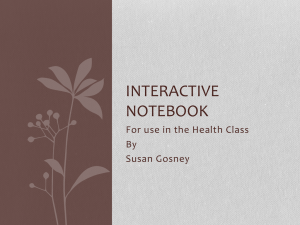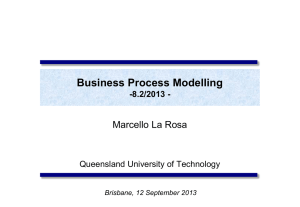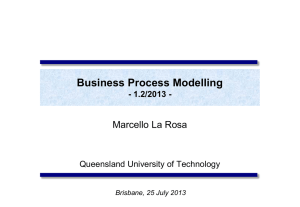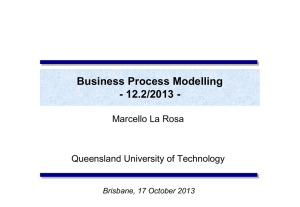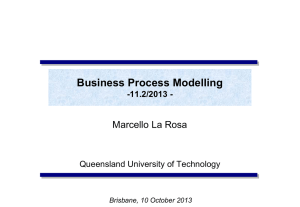Part 2 - Fundamentals of BPM
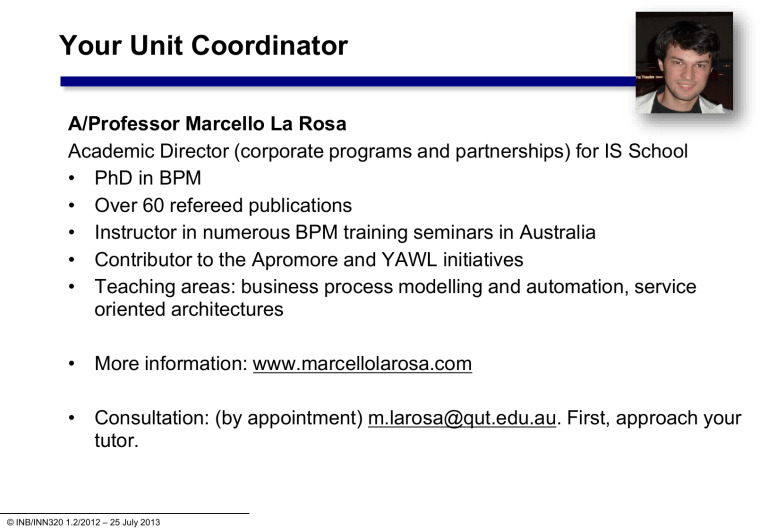
Your Unit Coordinator
A/Professor Marcello La Rosa
Academic Director (corporate programs and partnerships) for IS School
• PhD in BPM
• Over 60 refereed publications
• Instructor in numerous BPM training seminars in Australia
• Contributor to the Apromore and YAWL initiatives
• Teaching areas: business process modelling and automation, service oriented architectures
• More information: www.marcellolarosa.com
• Consultation: (by appointment) m.larosa@qut.edu.au. First, approach your tutor.
© INB/INN320 1.2/2012 – 25 July 2013
Your co-lecturers
Dr Thomas Kohlborn, Postdoctoral Research Fellow t.kohlborn@qut.edu.au
Dr Artem Polyvyanyy, Postdoctoral Research Fellow artem.polyvyanyy@qut.edu.au
Prof. Jan Recker, Woolworths Chair for Retail Innovation j.recker@qut.edu.au
© INB/INN320 1.2/2012 – 25 July 2013
2
Your Tutors
Eike Bernhard
(INB/INN)
Stephan Clemens
(INB/INN)
PhD Candidate eike.bernhard@qut.edu.au
© INB/INN320 1.2/2012 – 25 July 2013
Research Assistant stephan.clemens@qut.edu.au
3
Your Tutors
Raffaele Conforti
(INB)
Dr Jochen de Weerdt
(INB)
PhD Candidate raffaele.conforti@qut.edu.au
© INB/INN320 1.2/2012 – 25 July 2013
Postdoctoral Research Fellow jochen.deweerdt@qut.edu.au
4
Unit Structure
• Organisation of this subject
– Positioning of Business Process Modelling
– Objectives, Assessment, Resources
– Principles of Modelling
• Business process modelling languages
– Foundations of process modelling: Petri Nets
– Event-driven Process Chains (EPCs)
– Business Process Model and Notation (BPMN 2.0)
• Business process identification
• Business process discovery methods
• Managing process modelling projects
© INB/INN320 1.2/2012 – 25 July 2013
5
Unit Objectives
• Develop general skills in conceptual modelling, analytical and system thinking
• Develop team work
• Provide insights into popular process modelling techniques
(e.g. BPMN) and current tools (e.g. Signavio)
• Provide modelling skills which complement the managementcentred skills from INB/INN321, and the technical skills from
INN323
• Improve understanding of business-IT alignment
© INB/INN320 1.2/2012 – 25 July 2013
6
Business Process Management Curriculum
INB/N321
Business Process
Improvement
INB/N320
Business Process
Modelling
INB/N324
Business Process
Analytics
INN327
Business Process
Management
INN326
Advanced Business Process
Modelling
INN690
BPM Research Project
© INB/INN320 1.2/2012 – 25 July 2013
1 semester
INN323
Business Process
Automation
INN610
Case Studies in BPM
2 semester
Questions / Expectations
© INB/INN320 1.2/2012 – 25 July 2013
8
Assessment
• Assignment 1 (20%):
– Model a simple business process scenario by using one or more process modelling languages
– Demonstrate capability to deploy core modelling constructs
• Assignment 2 (30%):
– Model a complex business process scenario by using one or more process modelling languages and a variety of abstraction levels
– Demonstrate capability to deploy advanced modelling constructs and to establish a governance structure
• Exam (50%)
© INB/INN320 1.2/2012 – 25 July 2013
9
Assignment 1:
Basic Business Process Modelling
• Worth 20%
• Available from end of Week 3
• Individual or as team (up to 5 members)
• Conduct process modelling for a simple scenario
• Focus: build high-quality process models and present the results ( not about process improvement)
• INN students: Also use EPCs and compare EPCs/BPMN
• Deadline: 20 September (Week 9)
© INB/INN320 1.2/2012 – 25 July 2013
10
Assignment 2:
Advanced Business Process Modelling
• Worth 30%
• Available from end of Week 9
• Individual or as team (up to 5 members)
• Conduct process modelling for a complex scenario
• Focus: understand and model complex scenarios at various levels of abstraction for various audiences
• INN students: Also discuss governance (process architecture and modelling conventions)
• Deadline: 1 November
© INB/INN320 1.2/2012 – 25 July 2013
11
Exam
• 50%
• 3 hours
• During exam period
• Different for INB/INN
• See extract of previous exam on blackboard
• (no solutions available, please don’t ask)
© INB/INN320 1.2/2012 – 25 July 2013
12
Tutorials (From Week 2)
Focus: exercises, exercises, exercises...
Expectation: that you do the exercises at home, like in the old school days
3pm
4pm
5pm
6pm
7pm
8pm
Time
9am
10am
11am
12am
1pm
2pm
© INB/INN320 1.2/2012 – 25 July 2013
Mon Tue
S502
S506
Wed
S518
S503 (INN)
Thu
S503, S506
S507
S410 (CLASS)
S410 (CLASS)
S503 (INN)
Fri
13
INB320 Blackboard Page
INN320 students redirected to INB page
© INB/INN320 1.2/2012 – 25 July 2013
14
Our modelling tool: Signavio Academic Initiative
http://academic.signavio.com
© INB/INN320 1.2/2012 – 25 July 2013
15
Let’s get back to business…
© INB/INN320 1.2/2012 – 25 July 2013
16
Model Definition
A model is a representation of some phenomenon of the real world made in order to facilitate an understanding of its workings. A model is a simplified and generalized version.
• What phenomenon matters?
• How to represent this?
• How to facilitate understanding?
© INB/INN320 1.2/2012 – 25 July 2013
17
Basic modelling principles: Systems Theory
System
Element
External Element
© INB/INN320 1.2/2012 – 25 July 2013
Relationship
18
Systems
• Units of analysis, determined by the system boundaries
• One element can belong to many systems and a system is made out of many elements
• Interacts with (impacts and is impacted by) the system environment
• Example systems:
– Family
– Company
– Country
© INB/INN320 1.2/2012 – 25 July 2013
19
Elements
• An element is an entity of the system, e.g.
– Piace of data
– Employee
– Building
– IT resource
• Elements (instances) can be classified to element types
(Marcello A/Professor; A/Professor Employee)
• Various semantic relationships exist between elements
© INB/INN320 1.2/2012 – 25 July 2013
20
Semantic relationships
• Specialization
• Aggregation
• Composition
• Predecessor
• Successor
Hierarchical relationships
Order relationships
© INB/INN320 1.2/2012 – 25 July 2013
21
Specialisation
• “is a” relationship (sub-typing)
• Element B is a specialization of element A if and only if:
– every instance of element B is also an instance of element A; and
– there are instances of A which are not instances of B.
• E.g.: Student can be specialised in male and female student
• Opposite: Generalisation
• Differentiate
– disjoint or non-disjoint?
– total and non-total?
© INB/INN320 1.2/2012 – 25 July 2013
22
Example
Using ‘football player’ provide examples for:
• disjoint specializations
• non-disjoint specializations
• total specializations
• non-total specializations
• generalization
© INB/INN320 1.2/2012 – 25 July 2013
23
Aggregation
• used to combine simple elements to more complex ones
• “has a” relationship
• does not imply ownership
• e.g.: Students form a class. If a class is cancelled, its students continue to exist. A student can be enrolled in more than one class.
• see also bundles
© INB/INN320 1.2/2012 – 25 July 2013
24
Composition
• Like aggregation but implies ownership (“is part of”)
• e.g. a university owns six faculties. If the university closes, the faculties will no longer exist. Each faculty belongs to exactly one university.
• Containment is a special form of composition in which several instances of the same element are stored.
– Heart “is part of” human being (composition)
– Finger “is part of ” human being (containment)
© INB/INN320 1.2/2012 – 25 July 2013
25
Exam Question 2.2008
Use the following process model to provide an example for the difference between:
• process generalization/specialisation
• process aggregation/disaggregation.
© INB/INN320 1.2/2012 – 25 July 2013
26
Modelling for managing complexity
“Real” System
Generalization
Model System
© INB/INN320 1.2/2012 – 25 July 2013
Elimination
Aggregation/
Composition
27
References
© INB/INN320 1.2/2012 – 25 July 2013
28
Textbook (available as eBook from QUT Library)
Marlon Dumas, Marcello La Rosa,
Jan Mendling, Hajo A. Reijers
Fundamentals of
Business Process Management
Springer 2013
(Chapters 1-5) http://fundamentals-of-bpm.org
© INB/INN320 1.2/2012 – 25 July 2013
29
Recommendations
Bruce Silver
BPMN Method & Style
(2 nd Edition)
Cody-Cassidy Press 2012
(Except the part on executable process modelling) www.bpmnstyle.com
30
© INB/INN320 1.2/2012 – 25 July 2013
Recommendations
Matthias Weske
Business Process Management -
Concepts, Languages,
Architectures (2 nd Edition)
Springer 2012
(Part II on Business Process Modelling)
31
© INB/INN320 1.2/2012 – 25 July 2013
Recommendations
Joerg Becker, Martin Kugeler,
Michael Rosemann (eds.)
Process Management
(2 nd Edition)
Springer 2011
(Chapter 3)
32
© INB/INN320 1.2/2012 – 25 July 2013
© INB/INN320 1.2/2012 – 25 July 2013
A/Prof. Marcello La Rosa
IS School Academic Director
(Corporate Programs and Partnerships)
BPM Discipline, IS School
Science & Engineering Faculty
Queensland University of Technology
2 George Street
Brisbane QLD 4000
Australia p +61 (0)7 3138-9482 e m.larosa@qut.edu.au
w www.marcellolarosa.com

